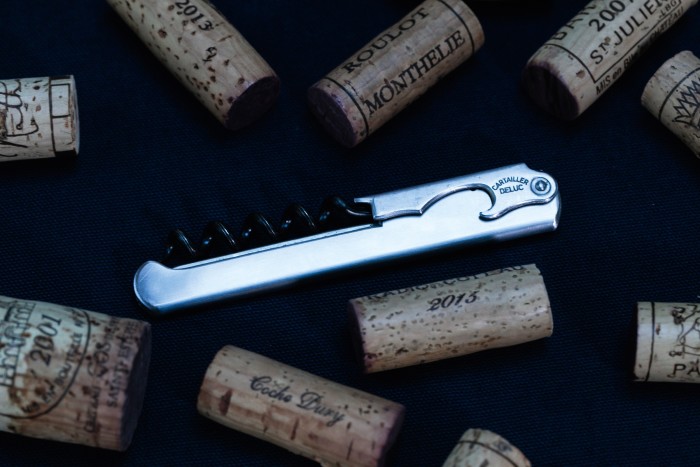The corkscrew has been through many iterations in its 300-year history. And these days kitchen departments bristle with over-engineered designs. Ask sommeliers what they actually use, though, and you’ll invariably get the same reply.
Patented in 1882 by the German inventor Karl Wienke, the waiter’s friend (also known as a wine knife, or wine key – a corruption of its creator’s surname) is universally loved by sommeliers partly because it’s so compact. Blessed with one, sometimes two levers that brace against the lip of the bottle to create a fulcrum, a corkscrew and, typically, a blade for cutting the foil, it can extract even the most stubborn cork with grace, yet is barely bigger than a penknife when it’s folded up.
The brand favoured by most cash-strapped somms is the Pulltap’s. It may not be the prettiest, but it does the job, and if it breaks, you can get another for just a few quid. Some wine pros, though, take their choice of corkscrew rather more seriously.

“Your corkscrew is like a golfer’s club, or a chef’s knife – it’s the most important tool you have,” says sommelier and former wine buyer for Caprice Holdings and The Birley Clubs, Guillem Kerambrun. A self-confessed helixophile (corkscrew obsessive), Kerambrun uses a Cartailler-Deluc, his “first love”: “It’s very thin, and delicate and light, but it’s strong too. I’ve had mine for 20 years.” He likes Cartailler-Delucs so much he now sells them through his website, myfrenchsommelier.com, from £25.
Magnums and jeroboams – which have heftier corks – can often spell the end for flimsy corkscrews. This was a problem that plagued a particularly hospitable client of fine-wine merchant Bordeaux Index. “He liked entertaining on a grand scale and complained that he was getting through Pulltaps at a rate of knots,” says buyer Giles Cooper. “We tried to find a solution that wasn’t crazily expensive, and when we couldn’t, we designed one ourselves.” The result, which has a rosewood handle and an extra-large, extra-long helix, will be made in limited quantities and can be ordered online for £50.
The ne plus ultra of wine keys is considered, by many pros, to be the Code 38. Hand-finished in a solar-powered studio in New South Wales, Australia, this oeno-weapon starts at $365 for a stainless-steel model, and rises to over $1,000 for the P-Type Titanium X – a beast boasting a pure titanium body, razor-sharp foil blade, changeable helix, “super-tough lifter” and “spring pre-loads”.
The brains behind Code 38 is Jeff Toering, a former aviation instrument engineer. “Essentially there is nothing really wrong with the basic waiter’s friend… it’s really quite good actually,” he says. “But most are made just about as cheaply as possible, which doesn’t bode well for a tool of the trade.” All that twisting and turning makes a corkscrew brittle, he explains, and much more likely to snap. So he fits his wine keys with a super-strong, heat-treated conical helix that thickens towards the shank.

The ergonomics, the finish, the blade, the screws – Toering has drilled down into every last detail. Each component is precision-machined using a form of technology usually reserved for making Swiss watches and aerospace parts. “The real thing that sets the Code 38 apart, however, is its modular design, which means that it can be completely stripped down and serviced in less than 60 seconds,” he says.
Albert Blaize, former sommelier at Le Manoir aux Quat’Saisons and The Clove Club, and author of Which Wine When, is sold. “You just have to open one bottle with a Code 38 and you’re converted. The build quality is exceptional, the body is indestructible and you don’t get the same amount of strain on your hands. When you’re popping 100 wines in a service, it really makes the difference.”
I tried the prototype for the 2022 P-Type Titanium X and it did indeed feel amazing in the hand: small, sleek and hard – like a very expensive flick-knife. The suede-y textured finish, the easy-to-open blade and the exceptionally pleasing click as it snaps shut – these are the kind of details that companies like Apple built whole empires on. The only problem I’ve now got is: finding a bottle of wine that’s up to scratch.

